
The Hollow Earth is a concept proposing that the planet Earth is entirely hollow or contains a substantial interior space. Notably suggested by Edmond Halley in the late 17th century, the notion was disproven, first tentatively by Pierre Bouguer in 1740, then definitively by Charles Hutton in his Schiehallion experiment around 1774.

Pellucidar is a fictional Hollow Earth invented by American writer Edgar Rice Burroughs for a series of action adventure stories. In a crossover event, Tarzan, who was also created by Burroughs, visits Pellucidar.
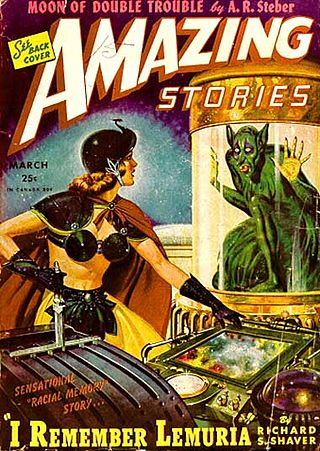
Richard Sharpe Shaver was an American writer and artist who achieved notoriety in the years following World War II as the author of controversial stories that were printed in science fiction magazines. In Shaver's story, he claimed that he had had personal experience of a sinister ancient civilization that harbored fantastic technology in caverns under the earth. The controversy stemmed from the claim by Shaver, and his editor and publisher Ray Palmer, that Shaver's writings, while presented in the guise of fiction, were fundamentally true. Shaver's stories were promoted by Ray Palmer as "The Shaver Mystery".

The Narrative of Arthur Gordon Pym of Nantucket, written in 1838, is the only complete novel by American writer Edgar Allan Poe. The work relates the tale of the young Arthur Gordon Pym, who stows away aboard a whaler called the Grampus. Various adventures and misadventures befall Pym, including shipwreck, mutiny, and cannibalism, before he is saved by the crew of the Jane Guy. Aboard this vessel, Pym and a sailor named Dirk Peters continue their adventures farther south. Docking on land, they encounter hostile, black-skinned natives before escaping back to the ocean. The novel ends abruptly as Pym and Peters continue toward the South Pole.
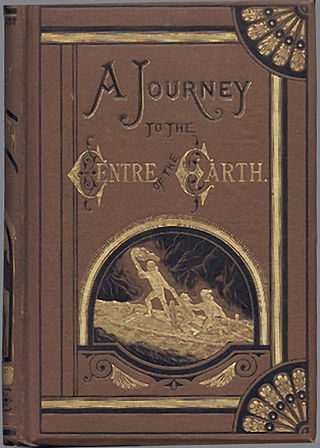
Journey to the Center of the Earth, also translated with the variant titles A Journey to the Centre of the Earth and A Journey into the Interior of the Earth, is a classic science fiction novel by Jules Verne. It was first published in French in 1864, then reissued in 1867 in a revised and expanded edition. Professor Otto Lidenbrock is the tale's central figure, an eccentric German scientist who believes there are volcanic tubes that reach to the very center of the earth. He, his nephew Axel, and their Icelandic guide Hans rappel into Iceland's celebrated inactive volcano Snæfellsjökull, then contend with many dangers, including cave-ins, subpolar tornadoes, an underground ocean, and living prehistoric creatures from the Mesozoic and Cenozoic eras. Eventually the three explorers are spewed back to the surface by an active volcano, Stromboli, located in southern Italy.

Subterranean fiction is a subgenre of adventure fiction, science fiction, or fantasy which focuses on fictional underground settings, sometimes at the center of the Earth or otherwise deep below the surface. The genre is based on, and has in turn influenced, the Hollow Earth theory. The earliest works in the genre were Enlightenment-era philosophical or allegorical works, in which the underground setting was often largely incidental. In the late 19th century, however, more pseudoscientific or proto-science-fictional motifs gained prevalence. Common themes have included a depiction of the underground world as more primitive than the surface, either culturally, technologically or biologically, or in some combination thereof. The former cases usually see the setting used as a venue for sword-and-sorcery fiction, while the latter often features cryptids or creatures extinct on the surface, such as dinosaurs or archaic humans. A less frequent theme has the underground world much more technologically advanced than the surface one, typically either as the refugium of a lost civilization, or as a secret base for space aliens.

The First Men in the Moon is a scientific romance, originally serialised in The Strand Magazine and The Cosmopolitan from November 1900 to June 1901 and published in hardcover in 1901, by the English author H. G. Wells, who called it one of his "fantastic stories". The novel tells the story of a journey to the Moon undertaken by the two protagonists: a businessman narrator, Mr. Bedford; and an eccentric scientist, Mr. Cavor. Bedford and Cavor discover that the Moon is inhabited by a sophisticated extraterrestrial civilisation of insect-like creatures they call "Selenites". The inspiration seems to come from the famous 1865 book by Jules Verne, From the Earth to the Moon, and the opera by Jacques Offenbach from 1875. Verne's novel also uses the word "Selenites" to describe inhabitants of the Moon.
The lost world is a subgenre of the fantasy or science fiction genres that involves the discovery of an unknown Earth civilization. It began as a subgenre of the late-Victorian adventure romance and remains popular into the 21st century.
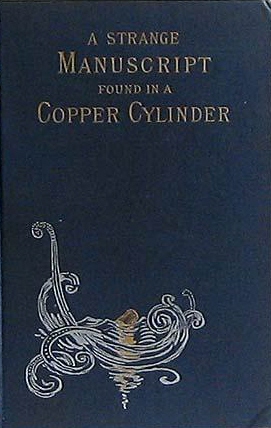
A Strange Manuscript Found in a Copper Cylinder is the most popular book by the Canadian writer James De Mille. It was serialized posthumously and anonymously in Harper's Weekly, and published in book form by Harper and Brothers of New York City during 1888. It was serialized subsequently in the United Kingdom and Australia, and published in book form in the United Kingdom and Canada. Later editions were published from the plates of Harper & Brothers' first edition during the late 19th and early 20th centuries.

John Uri Lloyd was an American pharmacist and leader of the eclectic medicine movement who was influential in the development of pharmacognosy, ethnobotany, economic botany, and herbalism.
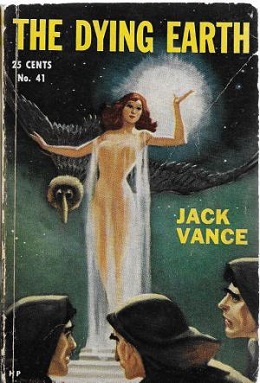
The Dying Earth is a collection of science fantasy/fantasy short fiction by American writer Jack Vance, published by Hillman in 1950. Vance returned to the setting in 1965 and thereafter, making it the first book in the Dying Earth series. It was retitled Mazirian the Magician in the Vance Integral Edition (2005), according to Jack Vance's expressed preference.
Simon Tyssot de Patot (1655–1738) was a French writer and poet during the Age of Enlightenment who penned two very important, seminal works in fantastic literature. Tyssot was born in London of French Huguenot parents. He was brought up in Rouans, moved to Delft (1662), Heusden (1676–1679) and Den Bosch, but spent most of his adult life in Deventer in the Netherlands, where he taught French and was professor of mathematics at the city's Athenaeum Illustre of Deventer. He had probably met John Locke in the 1680s and almost certainly knew the Irish deist John Toland, who lived at The Hague in 1708–10. His life proceeded relatively uneventfully until 1727, when at the age of 72 the publication of his "Lettres choisies" caused a scandal. He was accused of spinozism, irreligious and immoral views. Attempts to clear his name failed, he was dismissed from his post as professor and left the Hanseatic town. He died in 1738 in IJsselstein.
Spooksville is a series of 24 children's horror fiction books by American writer Christopher Pike. All 24 books were first published between 1995 and 1998. The series is set in a remote town in the USA and revolves around the lives of five of its young inhabitants. Although intended for a younger audience than his adult and young adult fiction, they contain some violence and may be considered unsuitable for younger children. A television series based on the book was commissioned and premiered on October 26, 2013 on the Hub Network.

Journey to the Center of the Earth is a 2008 American 3D science fantasy action-adventure film directed by Eric Brevig and starring Brendan Fraser in the main role, Josh Hutcherson, Anita Briem, and Seth Meyers. Produced by New Line Cinema, it is an adaptation of Jules Verne's 1864 novel, and was released in 3D theaters by Warner Bros. Pictures on July 11, 2008.
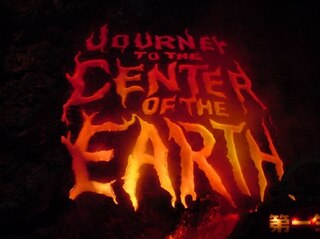
Journey to the Center of the Earth(センター・オブ・ジ・アース) is a slot car dark ride at the Tokyo DisneySea theme park in Urayasu, Chiba, Japan. One of the park's opening day attractions, it is located in the Jules Verne-themed Mysterious Island area of the park, and is loosely themed after Verne's 1864 novel of the same name. The attraction's ride system is based on the high speed slot car system originally created for the Test Track attraction opened in 1999 at Epcot in Walt Disney World. Original music for the ride was created by longtime Disney composer Buddy Baker.

Darwin's World, created by Dominic Covey, is a post-apocalyptic role-playing game first published under the d20 Open Game License in 2001. Originally designed as a quick adaptation of the 3rd Edition Dungeons & Dragons rules, the game has since been greatly expanded and revised and now utilizes the d20 Modern rules. Several Darwin's World books and supplements have seen print, though most support for the game is still only available in PDF format. In 2010, RPGObjects began producing game books using Pinnacle's Savage Worlds system.
Journey to Mars the Wonderful World: Its Beauty and Splendor; Its Mighty Races and Kingdoms; Its Final Doom is an 1894 science fiction novel written by Gustavus W. Pope. The book has attracted increased contemporary attention as a precedent and possible source for the famous Barsoom novels of Edgar Rice Burroughs. A sequel, Journey to Venus, followed in 1895.

The Man in the Moone is a book by the English divine and Church of England bishop Francis Godwin (1562–1633), describing a "voyage of utopian discovery". Long considered to be one of his early works, it is now generally thought to have been written in the late 1620s. It was first published posthumously in 1638 under the pseudonym of Domingo Gonsales. The work is notable for its role in what was called the "new astronomy", the branch of astronomy influenced especially by Nicolaus Copernicus. Although Copernicus is the only astronomer mentioned by name, the book also draws on the theories of Johannes Kepler and William Gilbert. Godwin's astronomical theories were greatly influenced by Galileo Galilei's Sidereus Nuncius (1610), but unlike Galileo, Godwin proposes that the dark spots on the Moon are seas, one of many parallels with Kepler's Somnium sive opus posthumum de astronomia lunari of 1634.
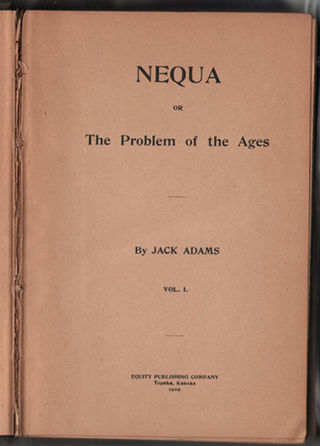
NEQUA or The Problem of the Ages is one of the first feminist science fiction books published in the United States. It was first serialized in the newspaper Equity. Two editions were published in Topeka, Kansas in 1900. The title page lists Jack Adams as the author. Jack Adams is a pseudonym.
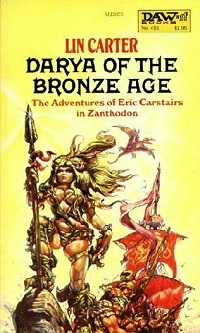
Darya of the Bronze Age is a science fiction novel by American writer Lin Carter, the fourth in his series about the fictional "Hollow Earth" land of Zanthodon. It was first published in paperback by DAW Books in September 1981, with an ebook edition following from Gateway/Orion in October 2018. It was also gathered together with the other volumes in the series into the omnibus ebook collection The Zanthodon Megapack.

















